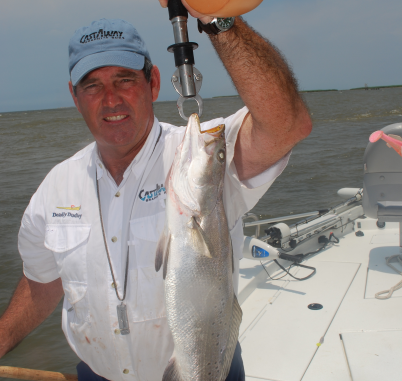
Sexton discusses tides and tips to catch more trout out of Venice
Ed Sexton is known for catching oversized trout out of Venice near the mouth of the Mississippi River.
In this excerpt from Trout Masters: How Louisiana Anglers Catch the Lunkers, Sexton shares his thoughts on fishing the tides and offers tips to help you catch more specks.
He does pay a lot of attention to tides.
“Some places are better on falling tides, and others are better on rising tides,” he said. “You need to fish the right place on the right tide. You learn those places by fishing a lot.”
He does feel that the best time to be fishing is about the time the tide changes. He fishes all tide ranges, but likes a 3/4- to 1-foot range best. It is his theory that big trout have only short periods during which they feed really well and that with strong tides the bite doesn’t last as long. His favorite times of the year to fish for trophy trout are the one-week periods before the full moons of April through July.
As the morning wore on, he still had no fish caught, a duplicate of the trip the previous evening. He moved constantly, trying different techniques, looking for a pattern.
“Fishing for big trout is not numbers fishing,” he explained. “You have got to be willing to not catch anything. You might fish all morning, and then finally get the one bite you’re looking for. Everyone says that they want to catch big trout, but I’m not sure they’re willing to do what it takes. It can come down to just getting that one bite. Fishing for big trout can be tedious.”
Eleven a.m. and still no fish. Then it happened! A turbo 10- to 15-count live shrimp produced a modest 2-pound speck. Then another, and another and another. Soon Sexton began to hammer 5-pound trout. He caught them on live shrimp, live croakers and soft-plastic lures. He caught them tight-line; he caught them under a cork. Even while he was catching fish, he never stopped experimenting.
Mixed in with the speckled trout were redfish, some of them really big, and a few crevalle jacks, both hard-fighting species that were quickly released by Sexton. Watching his powerful body on his low bow seat arch into the fish was like watching a combination of the uncoiling of a discus thrower and the power of the shot-putter. His bow seat seemed only 8 inches off the deck.
“I got short legs,” he said.
His live bait rods were rigged with 3 feet of fluorocarbon leader, terminating with No. 2, 4 and 6 treble hooks. The bigger the bait is, he explained, the bigger the hook he uses, 2s and 4s for croakers, 4s and 6s for shrimp. Shrimp and croakers are essentially drifted in the strong current, with only a ¼-ounce barrel sinker above the swivel connecting the leader to the line.
The ice chest rapidly filled. In spite of his bass-tournament background, Sexton is not “hung up,” to use his own words, about catch-and-release. He does admit to releasing more fish than he used to.
“Five- and 6-pounders are not really that good to eat,” he said. “Why not release them? But I’m not saying that I release all of them.”
Back at his snug camp, Sexton, who fishes two or three weekends a month, holidays and occasionally during the week if conditions are right, paused while packing to leave.
“The appeal of Venice to me is that it’s like the last frontier,” he said. “There is so much here you can hunt. There are freshwater fish. There are saltwater fish. That’s why people like me come down here. It’s so challenging.”
Ed Sexton’s tips
1) Go early and stay late. You can’t catch fish sitting at the camp.
2) Always keep good line on your reels. Check the line for abrasions and, if in doubt, cut it and retie the lure.
3) Keep cool when you have a big fish on. Play a big trout down, and don’t try to land it too green. You almost have to talk yourself calm while fighting a big fish.
4) Be open to learning new ways to catch big fish. Network with other fishermen, and read fishing magazines.
5) Take advantage when the bite is on. Don’t waste time cleaning blood off the boat. Take your pictures later. Don’t waste time between casts. This might be your chance to catch a big one. Bites are short.
6) Use a landing net big enough to net a big fish. Trophy trout are few. Increase your odds of getting them in the boat by using enough net.
Learn more about how the best guides and anglers across the Louisiana coast catch trout day in, day out by purchasing the Trout Masters Tool Kit, which includes a special package price for Trout Masters: How Louisiana’s Best Anglers Catch the Lunkers and Trout Masters Too: How the Pros do it.


